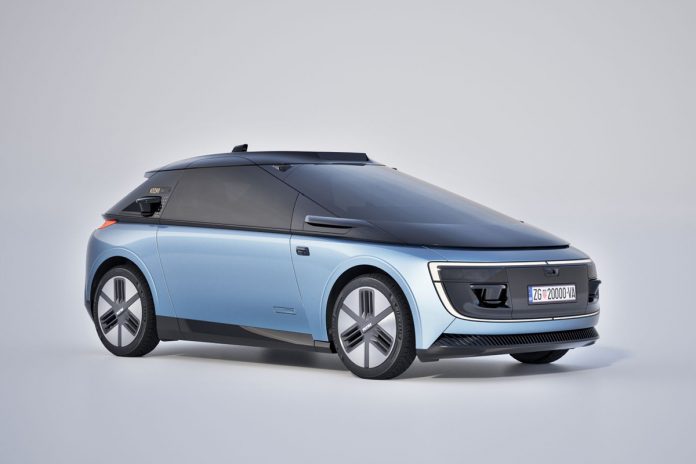Mate Rimac has revealed Verne, a new brand encompassing a Level 4 AV, robotaxi service, and enabling infrastructure.
Founded by Rimac, the new company will be led by Marko Pejković, who will serve as its CEO, with design operations lead by Adriano Murdri, the designer of Rimac’s Nevera EV and now Chief Design Officer at Verne. The new service to be offered by Verne, and its ecosystem more broadly, are based on three key elements: a fully autonomous EV, a bespoke smartphone app, and specialized infrastructure. Verne expects to launch its first service in Zagreb, Croatia in 2026.
Verne’s AV is built on an all-new platform designed around safety and comfort, with its autonomous functionality supported by the Mobileye Drive autonomous platform. At the same time, the vehicle’s design will take an autonomous-only approach, presented without a steering wheel or pedals. The mobility service platform (MSP) offered by Verne operates through a ride-hailing app, which will allow customers to see the robotaxi’s real-time location, check its estimated time of arrival, and personalize the robotaxi’s settings before entering the vehicle. This functionality will, for example, allow the user to set their preferred comfort, lighting, temperature, and scent. On the backend, Verne has said that its mobility platform leverages the benefits provided by a connected, autonomous, fleet to ensure a smooth, efficient, service in urban cities.
In each of the cities Verne will operate in, there will be a specialized infrastructure called the ‘Mothership’. This infrastructure will inspect, maintain, clean, and charge the AVs in Verne’s fleet on a daily basis – ensuring the customer receives a safe and clean vehicle upon request. Additionally, Verne is building its first production facility in Croatia to assemble, calibrate, and test its autonomous EVs before deploying them globally.
Digging deeper into its partnership with Mobileye, Verne confirmed that it had been working with the autonomous technology company for years. Through this collaboration, the Mobileye Drive will be integrated into the Verne vehicle and equipped with camera, radar and LiDAR sensors that together enable its automated driving capabilities. The platform itself is designed to be flexible and scalable, facilitating autonomous driving on different road types and weather conditions, while also taking local driving styles into account within its operational design domains.
Driving the in-cabin experience of Verne’s two-seater robotaxi is a 43-inch, ultrawide screen and a 17-speaker audio system. The cabin will likewise be preconditioned by the user to suit the comfort needs, while its ambiance, sound, and light are similarly configurable. These seats offer five different levels of comfort and enjoyment that Verne says will help the user work, relax, or rest. Between these seats is a Touchpad that allows users to interact with Verne’s in-vehicle system and adjust the vehicle’s settings. The Touchpad also features the Median, a physical switch used to start and stop the ride. Above the customer is a rounded sunroof called the Halo ring that enhances the experience further with a unique view of the vehicle’s surroundings.
The first Verne service will be launched in Zagreb. After Zagreb, Verne will roll out in other cities across Europe (arriving first in the UK and Germany), before reaching the Middle East. The company confirmed that it has already signed agreements with 11 cities in EU, UK and the Middle East, and is negotiating with a further 30 worldwide.
Through its offering, Verne hopes to offer a variety of economic, infrastructure, and social benefits to the cities it will operate in. Here, the company says that its mobility experience will boost the democratization of economic opportunities; while its infrastructure will help improve current transportation systems, reduce private car use, free up traffic lanes and parking spaces, and create more space in cities; and that it brings a social aspect through its sustainability, safety and efficiency.
In the longer term, Verne intends for its service to help remove the need for a second or third car in the household that takes up parking space, is used rarely, and can represent a high expense for many consumers.














